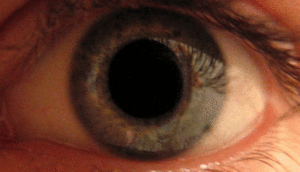We’ve all seen ultrasound augment the physical examination and even allow for assessments we could not otherwise accomplish at the bedside. One great example is the use of ultrasound to check the pupillary light reflex. If you are wondering why a pen light would not suffice for this physical examination standby, you have never encountered a patient with facial trauma whose eyes were swollen shut.
We already know what to look for without ultrasound (thanks to Greyson Orlando and Wikipedia for the GIF):
 By directing the beam of a high-frequency linear array transducer through the plane of the iris, you can obtain the following image (while shining a light through the closed eyelid of the same or contralateral eye):
By directing the beam of a high-frequency linear array transducer through the plane of the iris, you can obtain the following image (while shining a light through the closed eyelid of the same or contralateral eye):
It takes a bit of practice to align both planes, and not worth the trouble if the patient can open their eyes.
Placing a Tegaderm over the closed eye prior to applying gel can make cleanup much easier afterwards (a useful tip for any type of ocular ultrasound).
Further reading:
- Sargsyan AE, Hamilton DR, Melton SL, et al. Ultrasonic evaluation of pupillary light reflex. Critical Ultrasound Journal. 2009 1(2): 53-57.
- Harries A, Shah S, Teismann N, Price D, Nagdev A. Ultrasound assessment of extraocular movements and pupillary light reflex in ocular trauma. Am J Emerg Med. 2010 Oct; 28(8):956-9.
